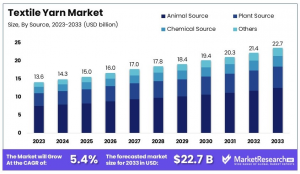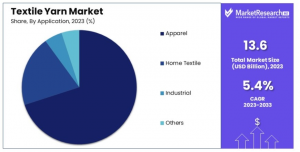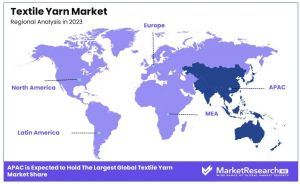Textile Yarn Market to Reach USD 22.7 Billion by 2033, Growing at 5.4% CAGR
Global Textile Yarn Market to Reach USD 22.7 Billion by 2033, Growing at a CAGR of 5.4% from USD 13.6 Billion in 2023
APAC holds 37% of the global textile yarn market, driven by strong textile manufacturing in China, India, Bangladesh, and rising demand for synthetic and natural yarns.”
NEW YORK, NY, UNITED STATES, February 3, 2025 /EINPresswire.com/ -- Market Overview— Tajammul Pangarkar
The Global Textile Yarn Market size is expected to be worth around USD 22.7 Billion by 2033, from USD 13.6 Billion in 2023, growing at a CAGR of 5.4% during the forecast period from 2024 to 2033.
The Textile Yarn Market involves the production and distribution of yarns used in the manufacturing of fabrics, apparel, and industrial textiles. These yarns, made from natural fibers like cotton and wool or synthetic fibers like polyester and nylon, serve as the foundational material for a wide range of textile applications.
The Textile Yarn Market is witnessing steady growth, driven by increasing demand for textiles across apparel, home furnishings, and industrial sectors. The rise in global population, urbanization, and disposable incomes has fueled the need for diverse textile products, directly boosting yarn production. Additionally, the growing popularity of sustainable and eco-friendly textiles has led to innovations in organic and recycled yarns, further expanding the market.
Governments in key textile-producing regions are investing heavily in the sector to enhance infrastructure, promote innovation, and support small and medium-sized enterprises (SMEs). Initiatives such as subsidies for sustainable practices, funding for R&D in advanced yarn technologies, and trade agreements to boost exports are creating a favorable environment for market growth.
Regulations are also playing a critical role, with stricter norms on environmental impact, labor practices, and material safety. Compliance with these regulations is pushing manufacturers to adopt cleaner production methods and sustainable sourcing, which aligns with global trends toward responsible consumption.
The Textile Yarn Market presents significant opportunities for both new entrants and established players. New players can focus on niche segments such as organic, recycled, or specialty yarns to differentiate themselves in a competitive market. Emphasizing sustainability, transparency, and innovation can help build brand credibility and attract eco-conscious consumers.
Existing players can leverage their expertise and scale to explore emerging markets and diversify their product portfolios. Investing in advanced technologies, such as automation and smart manufacturing, can improve efficiency and reduce costs. Collaborations with fashion brands, designers, and sustainability advocates can also enhance market presence and drive demand. By aligning with global trends and regulatory requirements, businesses can unlock growth potential and strengthen their position in the evolving textile yarn industry.
Curious About Market Trends? Request Your Complimentary Sample Report Today: https://marketresearch.biz/report/textile-yarn-market/request-sample/
Key Takeaway
-- Market Value: The Textile Yarn Market was valued at USD 13.6 billion in 2023 and is expected to reach USD 22.7 billion by 2033, with a CAGR of 5.4%.
--Source Analysis: Plant source dominates with 55%, highlighting the demand for natural fibers.
--Type Analysis: Cotton yarn dominates with 65%, emphasizing its extensive use in textiles.
--Application Analysis: Apparel application dominates with 70%, indicating its major consumption in clothing.
--Dominant Region: Asia Pacific leads with ~37%, driven by large-scale textile production.
Use Cases
Apparel Manufacturing: Textile yarn is a fundamental material in the production of clothing, including everyday wear, sportswear, and luxury fashion. It is used to create fabrics like cotton, polyester, and blends, catering to diverse consumer preferences.
Home Textiles: Yarn is essential for manufacturing home textile products such as bed linens, curtains, towels, and upholstery. These products require durable and high-quality yarn to ensure comfort and longevity.
Technical Textiles: Textile yarn is used in technical textiles for industrial applications, including automotive interiors, medical textiles, and geotextiles. These specialized yarns offer properties like strength, flame resistance, and water repellency.
Sustainable Yarn: With increasing environmental awareness, demand for eco-friendly yarn made from organic cotton, recycled polyester, and bamboo is rising. This trend aligns with the global push for sustainable fashion and textiles.
Handicrafts and Artisanal Products: Yarn is widely used in handicrafts like knitting, crocheting, and embroidery. Artisans and hobbyists rely on high-quality yarn to create unique and handmade products, supporting local economies and cultural traditions.
Driving Factors
Fast Fashion Impact: Rapid fashion cycles create constant demand for diverse yarn types. Manufacturers need quick access to various yarns for changing styles. This drives innovation in yarn production and variety.
Technical Textile Growth: Increasing demand for specialized yarns in technical applications. This includes medical textiles, protective wear, and industrial fabrics. Technical applications often require high-performance yarn varieties.
Sustainable Fiber Development: Growing demand for recycled and sustainable yarn options. Manufacturers are developing yarns from recycled materials and eco-friendly sources. This trend is particularly strong in premium market segments.
Athletic Wear Requirements: Sports and activewear markets need specialized performance yarns. Properties like moisture management and stretch are crucial. This drives development of advanced synthetic and blended yarns.
Manufacturing Automation: New spinning technologies are improving yarn quality and consistency. Automated production is reducing costs and increasing output. This helps meet growing demand while maintaining quality standards.
Report Segmentation
By Source
• Animal Source
• Plant Source
• Chemical Source
• Others
By Type
• Natural Yarn
• Animal Yarn
• Silk Yarn
• Wool Yarn
• Plant Yarn
• Cotton Yarn
• Flax Yarn
• Hemp Yarn
• Jute Yarn
• Ramie Yarn
• Artificial Yarn
• Polyester
• Nylon
• Acrylic
• Viscose
• Others
By Application
• Apparel
• Home Textile
• Industrial
• Others
Ready to Act on Market Opportunities? Buy Your Report Now and Get 30% off: https://marketresearch.biz/purchase-report/?report_id=48346
Regional Analysis
Asia Pacific leads the global textile yarn market with an estimated 37% share, driven by the region’s large-scale textile production and strong manufacturing capabilities. Countries such as China, India, and Bangladesh are key players in the textile industry, responsible for a significant portion of the world's textile production.
As a major exporter of finished textiles and apparel, the demand for textile yarn, which serves as a primary raw material in the production of fabrics, continues to rise. The growing textile and apparel industries in the region, along with the expanding demand for both synthetic and natural yarns, are key drivers of market growth.
Asia Pacific’s cost-effective manufacturing environment, coupled with advancements in textile technology and innovation, further fuels the region’s dominance. Additionally, the rising middle-class population and increasing disposable income in countries like India and China have boosted demand for high-quality, fashionable clothing, which in turn, increases the demand for yarns. As the textile industry in Asia Pacific continues to grow, so too will its dominance in the global textile yarn market.
Growth Opportunities
Sustainable and Eco-Friendly Yarns: With increasing environmental awareness, there is a growing demand for yarns made from organic cotton, recycled polyester, and other sustainable materials. Brands that adopt eco-friendly practices can attract environmentally conscious consumers.
Technical and Functional Yarns: Developing yarns with added functionalities, such as moisture-wicking, UV protection, and antimicrobial properties, can cater to the needs of the sportswear and outdoor apparel markets. These innovations can open new revenue streams.
Expansion into Emerging Markets: Countries in Asia, Africa, and South America are experiencing rapid industrialization and urbanization, leading to increased demand for textile products. Expanding into these regions can provide significant growth opportunities.
Customization and Niche Markets: Offering customized yarn solutions for specific industries, such as automotive, medical, and home textiles, can help companies differentiate themselves and capture niche markets.
Digital Transformation and Automation: Investing in advanced manufacturing technologies, such as automation and AI, can improve production efficiency, reduce costs, and enhance product quality. This can give companies a competitive edge in the market.
Key Players
• Vardhman Textiles Ltd.
• Grasim Industries Limited
• Raymond Ltd.
• Weiqiao Textile Company Limited
• Huvis Corporation
• Parkdale Mills Incorporated
• Hengli Group
• Indorama Ventures Public Company Limited
• Jaya Shree Textiles
• Kairuide Holding Co., Ltd.
• Shandong Demian Incorporated Company
• Alok Industries Ltd.
• Arvind Limited
• RSWM Ltd.
• PT. Indo-Rama Synthetics Tbk
Not Sure? Request a Sample Report and See How Our Insights Can Drive Your Business: https://marketresearch.biz/report/textile-yarn-market/request-sample/
Conclusion
In conclusion, the markets analyzed are all experiencing growth driven by evolving consumer preferences, technological advancements, and increasing demand for customized, high-quality products. Key trends, such as the adoption of sustainable practices, integration of smart technologies, and rising disposable incomes, are shaping the competitive landscape. While challenges such as market saturation, price sensitivity, and regional differences persist, opportunities abound for companies to capitalize on niche segments, leverage digital platforms, and innovate to meet the specific needs of their target audiences. As these industries continue to expand, businesses that adapt to changing trends, prioritize customer-centric strategies, and invest in innovation will be well-positioned for long-term success.
Related Report
Paper Packaging Material Market: https://marketresearch.biz/report/paper-packaging-material-market/
Printed Cartons Market: https://marketresearch.biz/report/printed-cartons-market/
Molded Pulp Packaging Market: https://marketresearch.biz/report/molded-pulp-packaging-market/
Polyhydroxybutyrate Market: https://marketresearch.biz/report/polyhydroxybutyrate-market/
Global Tobacco Market: https://marketresearch.biz/report/global-tobacco-market/
Breather Bags Market: https://marketresearch.biz/report/breather-bags-market/
Paper Straws Market: https://marketresearch.biz/report/paper-straws-market/
Lawrence John
Prudour
+91 91308 55334
Lawrence@prudour.com
Legal Disclaimer:
EIN Presswire provides this news content "as is" without warranty of any kind. We do not accept any responsibility or liability for the accuracy, content, images, videos, licenses, completeness, legality, or reliability of the information contained in this article. If you have any complaints or copyright issues related to this article, kindly contact the author above.



